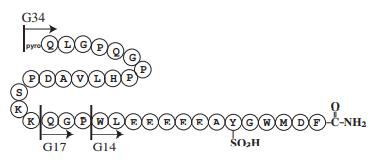Usage And Synthesis
Gastrin is released from G-cells in the antral mucosa in
response to nutrients, and stimulates gastric acid secretion.
In addition, gastrin is associated with the growth and
differentiation of the gastric mucosa. Gastrin was first purified from the pig antral mucosa,
and two gastrins of 17 aa peptides were identified in
1964. One peptide has O-sulfated tyrosine at the sixth
residue from the C-terminus (G17-II). The other peptide
is not sulfated (G17-I).
Human preprogastrin is composed of 101 aa residues.
Three mature peptides with different N-terminal extensions, namely big gastrin (G34), little gastrin (G17), and
small gastrin (G14), are formed by posttranslational processing. Furthermore, nonamidated glycine-extended gastrin is found in blood and tissues. Human
G17 contains a pyroglutamic acid residue in the
N-terminus, and is amidated at the C-terminus. In mammals, all gastrins possess sulfated tyrosine at the sixth
residue from the C-terminus. In vertebrates, the C-terminal four amino-acid sequence
(Trp-Met-Asp-Phe-NH2) that is responsible for receptor
activation is conserved. The position of sulfated tyrosine
differs between mammalian and nonmammalian gastrins,
being located at the sixth and seventh residue from the
C-terminus, respectively.


The human gastrin gene, GAST, location 17q21, consists of three exons. GAST mRNA is a 475-base transcript
that encodes the 101-aa preprogastrin. The structure of
Gast is conserved in mammals, except for the porcine
Gast, which has five exons. In mammals, exons 2 and 3
encode preprogastrin. The gastrin gene is mainly expressed in the G-cells of
the antral mucosa, and also in the duodenum, small intestine, pancreas, colon, pituitary, and testis.
Nutrients, including amino acids (particularly aromatic amino acids such as L-phenylalanine and L-tryptophan), amines, and calcium, are sensed by the luminal
side of antral G-cells, and stimulate gastrin secretion.
Gastrin-releasing peptide (GRP) that is secreted from
the gastric nerve induces the release of gastrin from
G-cells. The negative regulator of gastrin secretion is
somatostatin (SS). Increases in the H+ concentration of
the stomach stimulate SS release from antral D cells,
and SS inhibits gastrin secretion via SS receptor type 2
(SST2).
The gastrin receptor, known as the CCK2 receptor
(CCK2R) or CCK-B receptor (CCKBR), is a GPCR that
has seven transmembrane domains. Human CCK2R is
447 aa residues in length. Gastrin, nonsulfated gastrin,
CCK, and nonsulfated CCK bind to CCK2R with similar
affinity and potency. The dissociation constant (Kd) of
nonsulfated G17, CCK-8, and nonsulfated CCK-8 with
CCK2R are 10, 2, and 10 nM, respectively.
Gastrin, Nonsulfated gastrin, CCK, Nonsulfated CCK,
RB-400, PBC-264. YF-476, GV150013, L-740093, YM-022, JNJ-26070109,
L-365260, PR73870, LY262691.
Gastrin is secreted from antrum G-cells and induces
the synthesis and release of histamine from
enterochromaffin-like cells (ECL cells) through CCK2R.
Histamine binds to histamine H2 receptors and stimulates acid secretion in parietal cells. Furthermore, gastrin
directly activates acid secretion in parietal cells via
CCK2R. Studies of the mouse model of hypergastrinemia
and genetically modified mice have demonstrated that
gastrin is responsible for the normal growth and differentiation of the gastric mucos.
Zollinger-Ellison syndrome (ZES) is a clinical syndrome due to an ectopic gastrin-secreting tumor in the
duodenum or pancreas. Patients with ZES show gastric
acid hypersecretion, which induces refractory peptic
ulcers, severe gastroesophageal reflux disease, diarrhea,
and even death.9 Gastrin with a C-terminal Gly is produced by some tumors, including colorectal carcinoma.
Gastrin is a 17-residue polypeptide isolated from the antralmucosa. It was isolated originally in two different forms. Inone of the forms, the tyrosine residue in position 12 is sulfated.Both forms are biologically active. Cholinergic responseto the presence of food in the gastrointestinal tract providesthe stimulus for gastrin secretion. The lowering of pHin the stomach inhibits the secretion of gastrin. The effects ofstructural modification of gastrin on gastric acid secretionhave been reviewed. These studies revealed that the fourresidues at the COOH terminus retain significant biologicalactivity and that the aspartate residue is the most critical foractivity. The most important action of gastrin is to stimulatethe secretion of gastric acid and pepsin. Other actions of gastrininclude increased secretion of pancreatic enzymes; contractionof smooth muscles; water and electrolyte secretion bythe stomach and pancreas; water and electrolyte absorption bythe small intestine; and secretion of insulin, glucagon, and somatostatin.A synthetic pentapeptide derivative, pentagastrin,is currently used as a gastric acid secretagogue.
The plasma concentration of gastrin is measured by
RIA or ELISA,11 and can be used to diagnose gastrinsecreting tumors, atrophic gastritis, gastric ulcers, and
pernicious anemia. The gastrin test is performed to estimate acid secretory capacity and assess the extent of surgical vagotomy. It is also used to stimulate bioactive
neuropeptide secretion in patients with neuroendocrine
tumors such as vasoactive intestinal polypeptide secreting tumors.
PROMPT×
PROMPT
The What'sApp is temporarily not supported in mainland China
The What'sApp is temporarily not supported in mainland China
Cancel
Determine